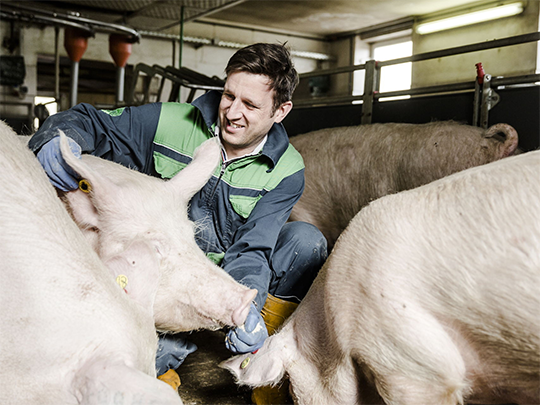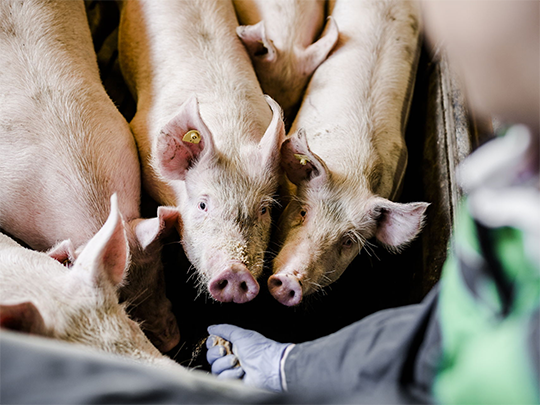Reduce ammonia emissions in pig production with phytogenics
When entering a pigsty, it often stings immediately in lungs and eye – the talk is about ammonia. Breathing becomes harder and eyes start to tear. After a short time of only 8 hours with a concentration of 20-25 ppm aerial ammonia, mucous membrane irritation occurs. In such an environment no pig or farmer wants to live or work. But there is a solution for this problem.

In animals, the bacterial enzyme urease is the main actor in ammonia formation. It is located in the intestine with the highest activity in cecum and colon as well as in animals’ feces. Here it functions as a transformer of urea in ammonia which is released in the environment. In addition to impairing the welfare of the animal, the released ammonia may lead to inferior performance and inefficient feed conversion. At high concentrations, aerial ammonia may cause irritation of the mucosal membrane of the respiratory tract, which in turn can reduce the animals' resilience.
Fact box
As shown in a trial of the HBLFA Gumpenstein (Austria), ammonia concentrations over 40 ppm may result in …
- a prolonged fattening period by up to 6 days,
- reduced daily weight gain by max 7 % and in addition,
- feed conversion ratio worsens by max 9 %.
Not a good basis for truly successful animal husbandry.
| Aerial NH3 content (ppm) | Effects |
| 5 | Smallest amount detectable olfactory |
| 6 | Start of corrosion of mucosa in eyes and respiratory tract |
| 11 | Animal performance decreases |
| 25 | Exposure threshold limit value for workers (for 8h exposure) (NIOSH) |
| 35 | Max. level for 10 min exposure |
| 40 | Headache, nausea, vomitus, general weakness and lethargy |
| 50 | Dangerous health effects, pneumonia |
| 100 | Constant cough, salivation, permanent damage of mucosa in animals and staff |
How can the farmer improve the air quality in the barn and thus increase the performance?
One solution is the use of saponins in feed: those plant derived substances have the ability to bind ammonia directly and inhibit enzymes involved in urea degradation. In vivo trials show that the use of phytogenic products with additional saponins reduce ammonia emissions up to 26 % throughout the pig’s life cycle. Thus, a lesser amount of ammonia is released in barn air of which both, farmers and pigs, will profit. A reduction of aerial ammonia concentrations in pigsties increases the profitability of pig fattening: Performance depressions of the animals may decrease, while daily gains and feed conversion stay on a high level. Moreover, the reduction of ammonia emissions makes a valuable contribution to greenhouse gas reduction. This is very important for agriculture, as it helps to meet the legal requirements for reducing emissions.

By taking advantage of the synergistic effects of various groups of active ingredients such as essential oils, herbs, spices, mucilages, flavonoids and saponins, Delacon is one step ahead:
The highly efficient and unique composition of phytogenic additives is adjusted to the life phase of the animal and does not only support the resilience of the animal. It also benefits the environment and enhances the working condition and profit for the farmer.
Did you know?
Ammonia does not only affect the environment, it also has a negative impact on livestock:
• High aerial ammonia concentrations favor tail biting
• Ammonia in the pig’s gut, which results from excessive protein feeding, must be detoxified via the liver. Huge amounts of ammonia lead to liver stress and higher energy consumption
• Aerial ammonia irritates the nose, throat and respiratory tract; high concentrations cause epithelial damage to the mucous membranes and reduce the self-cleaning capacity of the lungs
• Increased aerial ammonia concentrations delay the sexual maturity; for example, it reduces the ability of sows to perceive olfactory cues from the boars
Combining management strategies, phase-specific protein feeding and dietary addition of PFAs containing saponins are effective approaches to reduce ammonia emissions in barns.
References available upon request
What are you doing to reduce ammonia emissions in pig barns?

Anne Oberdorf
Anne has always been fascinated by the unknown, the diversity and beauty of nature. Her love for nature brought her to Delacon in 2018 after studying agricultural sciences, where she worked as Technical Communications Manager and later as Product Manager Aquaculture. Since February 2021, she has been taking a new, natural career path outside of Delacon.










